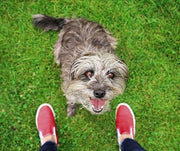Relief for Canine Stress and Anxiety

Watching a dog suffer from anxiety and stress is no picnic and that's putting it mildly at best. Sources of canine stress and anxiety can come from a variety of different factors. From fireworks to thunderstorms, short-term vacation plans to a long-distance relocation process, millions of dogs suffer every day.
Even encounters with strangers or other animals in the household can cause unnecessary grief. Loud noises are of particular concern, everyday occurrences like piercing police sirens, the blaring of a passing motorcycle, and the ring of a doorbell can send an otherwise calm pet into a terrible tizzy that we can’t seem to control.
Symptoms of these types of stressors, especially those associated with things like thunderstorms and fireworks, can include:
- Excessive panting, pacing, cowering, and/or hiding
- Non-stop whining, howling, growling, and barking that can annoy neighbors
- Destructive behaviors, digging, chewing, and attempts to escape near doorways
- Shivering, shaking, chewing, and excessive licking that can lead to self-harm
- Difficulty breathing, and/or respiratory distress
- An elevated heart rate is known as tachycardia
Over time, these unhealthy occurrences could eventually lead to increased sickness for your beloved best friend. Even if these events are rare (like once a year on the Fourth of July), the stress put on an animal can affect their overall health and well-being. Not to mention that pet parents are also experiencing overwhelming stress during these difficult times.
Some pet parents seek options like using pharmaceuticals to sedate their pets during the holidays and others look at natural remedies. These solutions work to a degree for some but do not solve the problem. Either way, pet parents are left without a solid solution they can trust for this often debilitating, long-term problem.
A Long-Term Solution
Fortunately, there are other types of solutions, even ones that are completely non-invasive and devoid of drug intervention. To avoid long-term health problems, it’s crucial to treat anxiety when it occurs in our pets and help bring them back to calm.
Acceptance and Love
Imagine yourself in a loving, calm embrace, like getting a gentle massage with classical music playing in the background. With a treatment option like this available for dogs why turn to other more invasive or unproven treatments? However, it’s always recommended to introduce any new treatment, routine, or process to your dog slowly and gradually so as not to further exacerbate his anxiety.
As with any type of new routine, be it diet, exercise, or treatment, be sure to check with your veterinarian to rule out any underlying health concerns before treating for anxiety. With so many solutions available, it’s important to find the one that works best, and most effectively, for your dog so that you can live a happy and healthy life together.
Previous article

Next article

Related posts
View all-

Keep Your Pets Safe During the Holidays
The holiday season brings joy, festivities, and a break from the usual routine. While you're enjoying the celebrations, it's important to remember that the holidays can present unique challenges for our furry family members. The new sights, sounds, and people can be overwhelming, and common festive items can pose unexpected risks.
Read Article -

Holiday Gifts for Every Pet Personality: The Ultimate Guide
The holiday season is finally here, and for many of us, that means finding the perfect presents for the ones we love most—our pets. Whether they are a steadfast dog who never leaves your side or an independent cat who graces you with their presence on their own terms, our pets are cherished members of the family. They deserve to celebrate right alongside us, stocking stuffers and all.
Read Article -

How to Keep Your Pet Calm During Thanksgiving
Thanksgiving is a time for family, friends, and food, but for our pets, the holiday can be overwhelming. The sudden change in routine, unfamiliar faces and scents, and increased noise can trigger significant stress. Understanding why your pet might feel anxious is the first step toward creating a peaceful holiday experience for everyone, including your furry family members. This guide offers calming tips for pets and practical solutions to ensure your dog or cat feels safe and secure during the festivities.
Read Article



